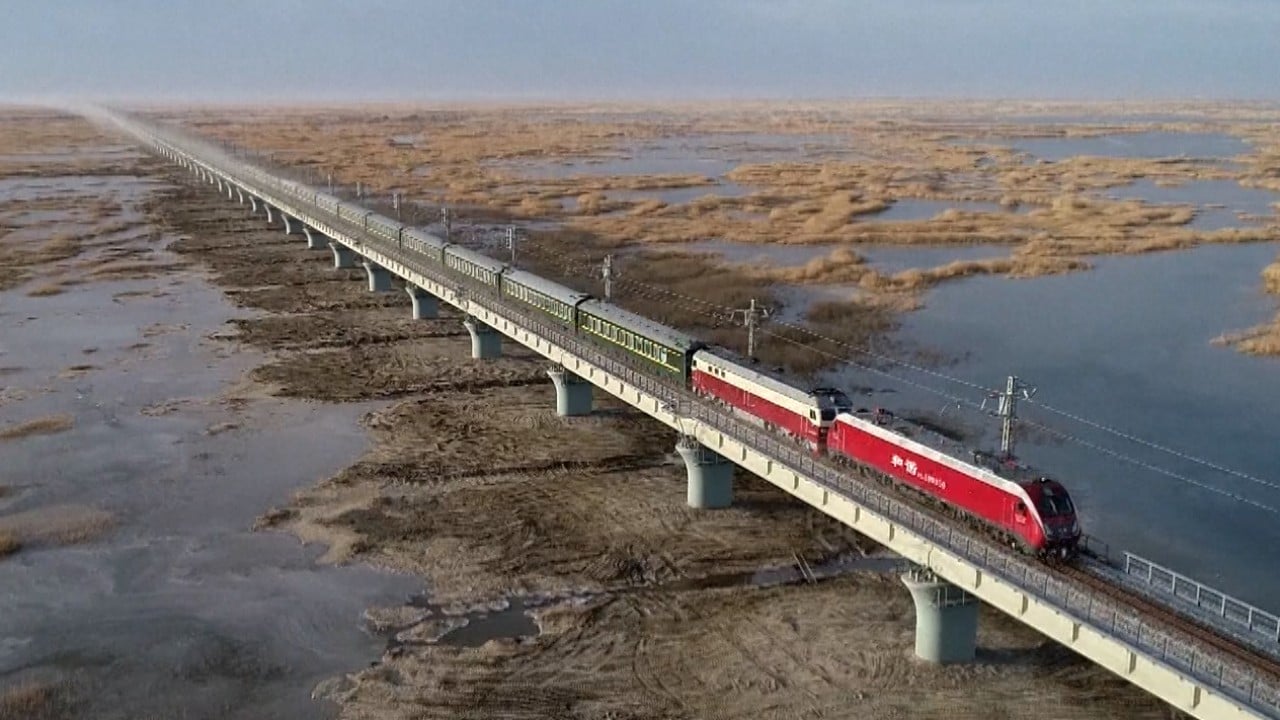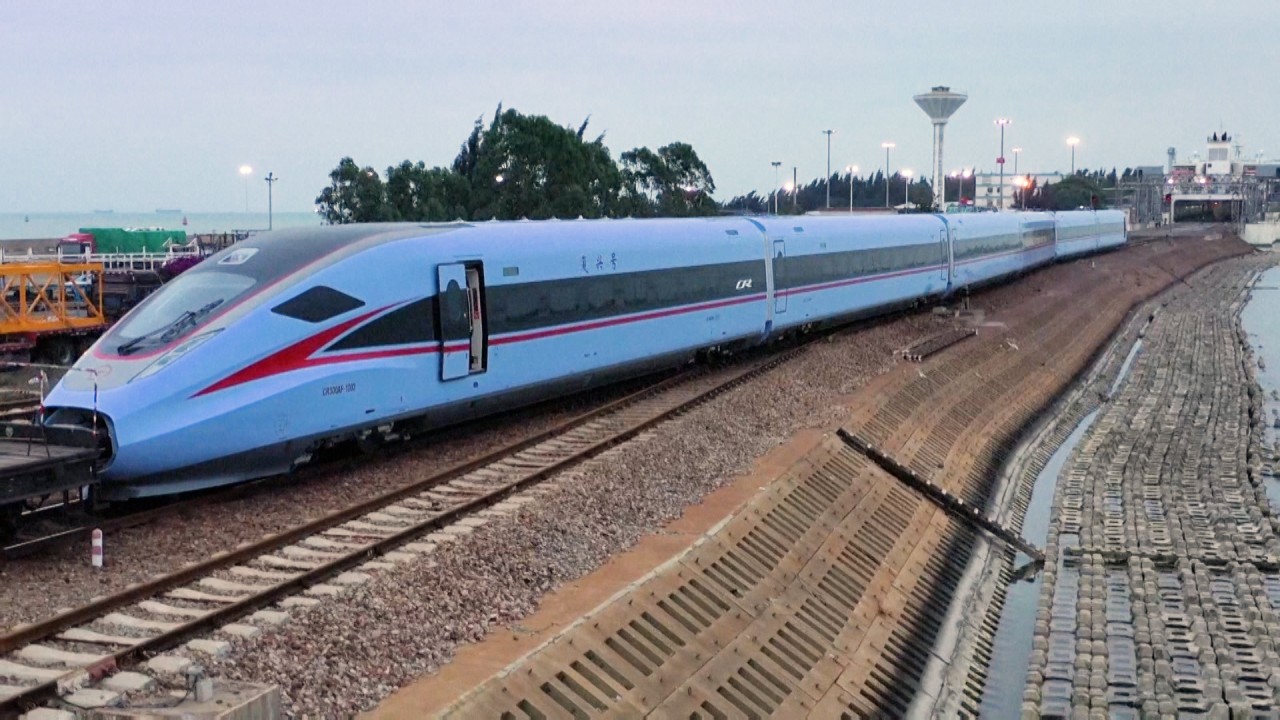
China’s debt reduction like putting the ‘genie back in the bottle’, but can it succeed to aid the economy?
- While China’s economy has largely recovered from the impact of the coronavirus, its debt surged to 280 per cent of gross domestic product (GDP) in 2020
- China is still building infrastructure projects, but Beijing is now setting the bar higher amid historically high debt levels
This is the third part in a series of stories looking at China’s economic outlook in the second half of 2021 as it continues its recovery from a coronavirus-hit 2020.
China has long relied on the old playbook of investing in infrastructure projects to boost its economy, particularly its high-speed railway network that is the largest in the world. And Beijing even said at the start of the year that its high-speed rail network could nearly double in size over the next 15 years.
Projects are still being built in major cities – like the second phase of the mass transit network Foshan city in Guangdong province costing 77.21 billion yuan (US$12 billion) – but Beijing is now setting the bar higher.
China's debt-to-GDP ratio
| Year | Debt-to-GDP ratio |
|---|---|
| 2020 | 279.4% |
| 2019 | 255.9% |
| 2018 | 249% |
| 2017 | 252% |
| 2016 | 248.6% |
Source: People's Bank of China
Beijing is well aware that high levels of debt reduce leeway for the economy to grow and pose a significant risk to China’s financial system and economy.
These efforts to reduce debt are expected to put downward pressure on Chinese growth in coming years, meaning without the option to turn to a one-size-fits-all strategy to cut back debt growth given the disparities in regional economies, the government has to tread carefully with its remedies.
Property loans and hidden local government debt still remain potential threats to our financial stability. We call them grey rhinos
But Michael Pettis, a professor of finance at Peking University, expects China’s debt growth this year will be among the lowest of the past decade.
“Mainly because Beijing seems to be reining in wasteful investment in infrastructure and property,” he said.
“If it were not wasteful, debt would have gone up in the past decade, but gross domestic product (GDP) would have gone up even more, so that the debt-to-GDP ratio would not have deteriorated so dramatically. I still expect the debt-to-GDP ratio, however, to rise a little in 2021.”

01:28
China builds over 4,000km of railway in 2020
And the total size of the debt pile is not yet clear, given moves by local governments to borrow outside their budget, resulting in so-called hidden debt.
“Property loans and hidden local government debt still remain potential threats to our financial stability. We call them grey rhinos,” said Wang Zhaoxing, former vice-chairman of China Banking and Insurance Regulatory Commission last month, referring to a problem that is well known but not adequately addressed.
In June, the local branch of the National Development and Reform Commission, the nation’s economic planner, in Hengyang city in Hunan province said that it would consider an application for a new underground project at “an appropriate” time. They explained that the central government “is currently strictly controlling the construction of urban rail transit” to “effectively prevent and resolve hidden debts of local governments”.
Beijing went so far as to place a cap on its overall debt at 250 per cent of GDP in 2017, but the pandemic scuppered that plan, and last year the government rolled out a fiscal stimulus package of nearly 3.6 trillion yuan (US$557 billion) to rescue its pandemic-hit economy, sending the ratio above the limit.
The Chinese government is now trying to put the genie back in the bottle, pressuring local governments and indebted companies to clean up their balance sheets and reduce their borrowing
“For local governments, we expect a sustained structural change in their debt profile due to policies to restrain hidden debt. The central government continues to allow local governments to issue direct debt while tightening control on new borrowings by local government financing vehicles, even if [the proceeds] are used for public services,” Yin said.
“The Chinese government is now trying to put the genie back in the bottle, pressuring local governments and indebted companies to clean up their balance sheets and reduce their borrowing,” said Borst.
A research note published by Macquarie Group last month said that as a result of tight fiscal stance, growth of infrastructure investment was sluggish in the first half of this year compared to the first half of 2019.
Fiscal austerity has also slowed down local government bond issuance, which was also weaker in the first half of the year, largely because Beijing raised the bar to apply for special purpose bonds, which are used by local governments to fund infrastructure investment.
Since 2015, Beijing has encouraged local governments to issue special purpose bonds in a bid to gradually phase out the use of local government financing vehicles because of their poor transparency.
But just 28 per cent of the annual special purpose bond quota for 2021 was issued in the first half of this year, compared to around 60 per cent in 2019 and 2020 over the same period, Macquarie said.

01:12
Blue high-speed trains match south China's Hainan island’s sky and sea
Government bond issuance, though, is set to accelerate in the second half of the year because there are projects that can add value to the economy which will receive approval to proceed in the coming months, analysts said.
However, the total issuance of special purpose bonds this year may not hit the annual quota of 3.65 trillion yuan (US$565 billion).
“The modest shift in policymaking towards focusing on leverage, de-risking, improving investment allocation, away from growth – I think that would be reflected in the outcome for the special purpose bond quota for this year, we might not see that exhausted as we have in the past,” said Martin Petch, vice-president and senior credit officer at Moody’s Investors Service.
There are also questions whether the tight fiscal policy stance has actually been effective in reducing China’s debt-to-GDP ratio, although official figures suggest that China’s overall leverage ratio has fallen since the start of the year.
The fact that China quotes GDP growth on a year on year basis confuses this point because of the enormous base effect
In the second quarter of 2021, China’s debt-to-GDP ratio decreased by 2.6 percentage points to 265.4 per cent from 268 per cent at the end of the first quarter.
In the first half of this year, it fell by 4.7 percentage points, according to the National Institution for Finance & Development (NFID), a government-linked think tank, based on data from the PBOC.
Peking University’s Pettis, however, believes that China’s public debt level is actually higher than the NFID’s estimate and continued to grow from the end of last year to the second quarter of this year, with an annualised growth rate of 9.6 per cent in the first half of 2021.
“In other words, the official measure of debt grew much faster than any meaningful measure of GDP, which means by definition the country’s debt-to-GDP ratio got worse, not better. The fact that China quotes GDP growth on a year on year basis confuses this point because of the enormous base effect,” Pettis said.
Researchers also said Beijing’s one-size-fits-all measure to clamp down on all local government debt might backfire, leading to higher risk to the regional economies and to the financial system.
“When it comes to deleveraging, it is not only that the regulators are going all-out, but governments at all levels are also being proactive, because the leverage ratio will be used as the benchmark for their performance assessment.” said economist Huang Yiping, a former adviser to the monetary policy committee of China’s central bank in April.
“It is easy to go from one extreme to another. And especially for financial issues, it is dangerous to be swinging between extremes.”
Wang Ren, a finance professor at Chongqing Technology and Business University, said that based on debt and economic data covering 158 cities in China, developed cities are able to make better use of debt to lift its overall regional growth than smaller cities, so those economies have, in fact, benefited from debt expansion.
It is not appropriate to adopt one-size-fits-all control measures for local government debt risks, but it should be based on regional characteristics
“It is not appropriate to adopt one-size-fits-all control measures for local government debt risks, but it should be based on regional characteristics,” Wang wrote in the Shanghai-based The Paper in July.
While it makes economic sense to distinguish debt in poorer cities compared to richer ones, Pettis believes it is difficult to roll out given Beijing’s objectives in narrowing the nation’s large income gap.
“From an economic point of view it makes sense to be more restrictive with the less efficient poorer provinces than with the more efficient ones. The problem of course is that this conflicts with Beijing’s goal of equalising income across provinces,” Pettis said.








